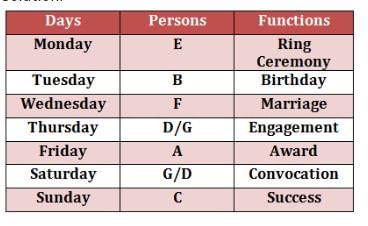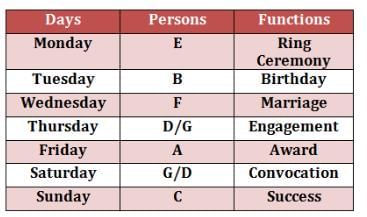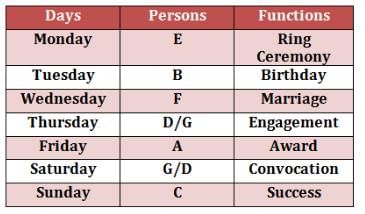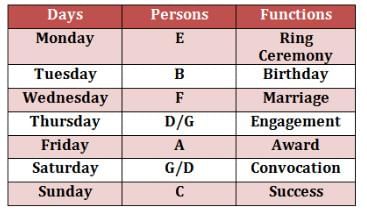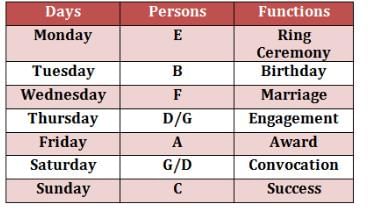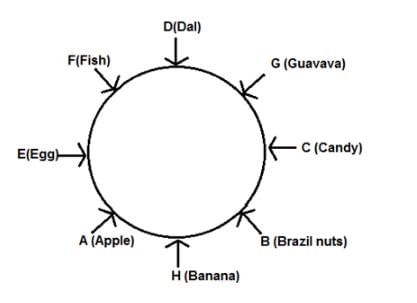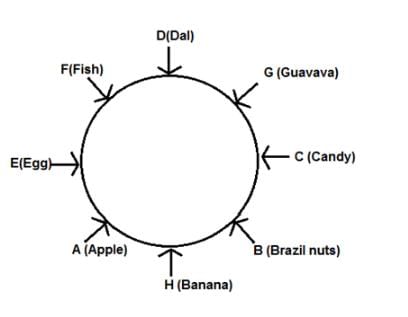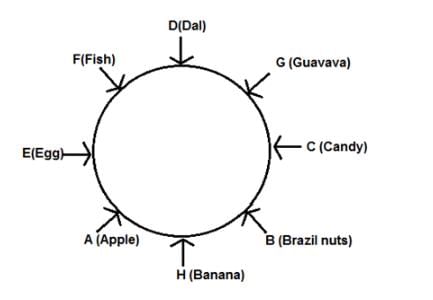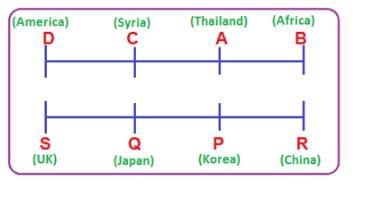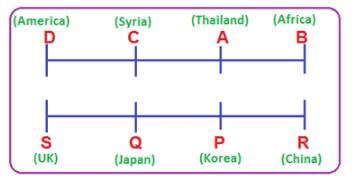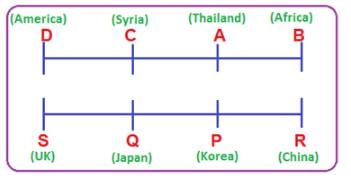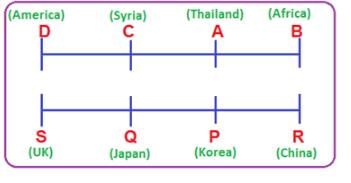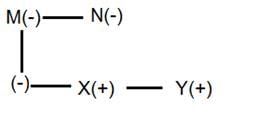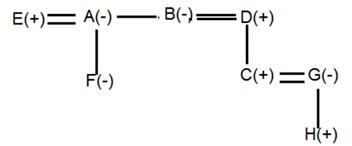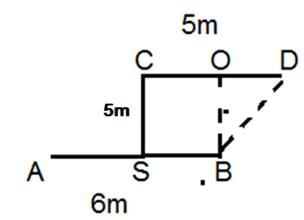NIACL Mock Test - 9 - Insurance MCQ
30 Questions MCQ Test - NIACL Mock Test - 9
Study the following information carefully to answer the given questions.
Seven friends A, B, C, D, E, F and G attend different functions namely Marriage, Ring ceremony, Award, Birthday, Engagement, Success and Convocation but not necessarily in the same order from Monday to Sunday.
A attends a function on Friday. Only 2 persons attend functions between A and the one who is attending Birthday. B attends a function immediately after E. Neither F nor D is attending Birthday. Only one person attends a function between F and the one who is attending Award.
The one who is attending Award does not have a function on Monday. B attends a function immediately before the one who is attending marriage. A is not attending marriage. Only one person attends a function between F and E. C is attending Success but not on Thursday. Only 2 persons attend functions between C and the one who is attending Engagement. E is not attending Convocation.
Q. Which of the following function is E attending?
A attends a function on Friday. Only 2 persons attend functions between A and the one who is attending Birthday. B attends a function immediately after E. Neither F nor D is attending Birthday. Only one person attends a function between F and the one who is attending Award.
The one who is attending Award does not have a function on Monday. B attends a function immediately before the one who is attending marriage. A is not attending marriage. Only one person attends a function between F and E. C is attending Success but not on Thursday. Only 2 persons attend functions between C and the one who is attending Engagement. E is not attending Convocation.
Study the following information carefully to answer the given questions.
Seven friends A, B, C, D, E, F and G attend different functions namely Marriage, Ring ceremony, Award, Birthday, Engagement, Success and Convocation but not necessarily in the same order from Monday to Sunday.
A attends a function on Friday. Only 2 persons attend functions between A and the one who is attending Birthday. B attends a function immediately after E. Neither F nor D is attending Birthday. Only one person attends a function between F and the one who is attending Award.
The one who is attending Award does not have a function on Monday. B attends a function immediately before the one who is attending marriage. A is not attending marriage. Only one person attends a function between F and E. C is attending Success but not on Thursday. Only 2 persons attend functions between C and the one who is attending Engagement. E is not attending Convocation.
Q. If G has function on Saturday .On which of the following day does D have a function ?
A attends a function on Friday. Only 2 persons attend functions between A and the one who is attending Birthday. B attends a function immediately after E. Neither F nor D is attending Birthday. Only one person attends a function between F and the one who is attending Award.
The one who is attending Award does not have a function on Monday. B attends a function immediately before the one who is attending marriage. A is not attending marriage. Only one person attends a function between F and E. C is attending Success but not on Thursday. Only 2 persons attend functions between C and the one who is attending Engagement. E is not attending Convocation.
Study the following information carefully to answer the given questions.
Seven friends A, B, C, D, E, F and G attend different functions namely Marriage, Ring ceremony, Award, Birthday, Engagement, Success and Convocation but not necessarily in the same order from Monday to Sunday.
A attends a function on Friday. Only 2 persons attend functions between A and the one who is attending Birthday. B attends a function immediately after E. Neither F nor D is attending Birthday. Only one person attends a function between F and the one who is attending Award.
The one who is attending Award does not have a function on Monday. B attends a function immediately before the one who is attending marriage. A is not attending marriage. Only one person attends a function between F and E. C is attending Success but not on Thursday. Only 2 persons attend functions between C and the one who is attending Engagement. E is not attending Convocation.
Q. Who among the following is attending Convocation?
A attends a function on Friday. Only 2 persons attend functions between A and the one who is attending Birthday. B attends a function immediately after E. Neither F nor D is attending Birthday. Only one person attends a function between F and the one who is attending Award.
The one who is attending Award does not have a function on Monday. B attends a function immediately before the one who is attending marriage. A is not attending marriage. Only one person attends a function between F and E. C is attending Success but not on Thursday. Only 2 persons attend functions between C and the one who is attending Engagement. E is not attending Convocation.
Study the following information carefully to answer the given questions.
Seven friends A, B, C, D, E, F and G attend different functions namely Marriage, Ring ceremony, Award, Birthday, Engagement, Success and Convocation but not necessarily in the same order from Monday to Sunday.
A attends a function on Friday. Only 2 persons attend functions between A and the one who is attending Birthday. B attends a function immediately after E. Neither F nor D is attending Birthday. Only one person attends a function between F and the one who is attending Award.
The one who is attending Award does not have a function on Monday. B attends a function immediately before the one who is attending marriage. A is not attending marriage. Only one person attends a function between F and E. C is attending Success but not on Thursday. Only 2 persons attend functions between C and the one who is attending Engagement. E is not attending Convocation.
Q. Who among the following have functions immediately before F?
Study the following information carefully to answer the given questions.
Seven friends A, B, C, D, E, F and G attend different functions namely Marriage, Ring ceremony, Award, Birthday, Engagement, Success and Convocation but not necessarily in the same order from Monday to Sunday.
A attends a function on Friday. Only 2 persons attend functions between A and the one who is attending Birthday. B attends a function immediately after E. Neither F nor D is attending Birthday. Only one person attends a function between F and the one who is attending Award.
The one who is attending Award does not have a function on Monday. B attends a function immediately before the one who is attending marriage. A is not attending marriage. Only one person attends a function between F and E. C is attending Success but not on Thursday. Only 2 persons attend functions between C and the one who is attending Engagement. E is not attending Convocation.
Q. Which of the following is correct in the given options?
Study the following information carefully and answer the questions which follow–
Eight persons viz. A, B, C, D, E, F, G and H like eight different food items viz. candy, guava, egg, banana, brazil nuts, apple, fish, and dal not necessarily in the same order. They are sitting around a circular table facing the centre of the circle at an equal distance. F is third to the left of the one who likes banana, who is opposite to the one who is second to the right of C. The one who likes fish is not near to A but near the one who is opposite to C. H and B are adjacent to each other but neither of them likes Apple. The one who likes candy is second to the left of the one who likes dal, who is next to the one who likes Fish and G. The one who likes Apple is seated opposite to G. The one who likes egg is neither D nor near to C. The one who likes Guavava is third to the right of H.
Q. Who is immediate right of G?
Study the following information carefully and answer the questions which follow–
Eight persons viz. A, B, C, D, E, F, G and H like eight different food items viz. candy, guava, egg, banana, brazil nuts, apple, fish, and dal not necessarily in the same order. They are sitting around a circular table facing the centre of the circle at an equal distance. F is third to the left of the one who likes banana, who is opposite to the one who is second to the right of C. The one who likes fish is not near to A but near the one who is opposite to C. H and B are adjacent to each other but neither of them likes Apple. The one who likes candy is second to the left of the one who likes dal, who is next to the one who likes Fish and G. The one who likes Apple is seated opposite to G. The one who likes egg is neither D nor near to C. The one who likes Guavava is third to the right of H.
Q. Which of the following pair of persons are sitting opposite to each other?
Study the following information carefully and answer the questions which follow–
Eight persons viz. A, B, C, D, E, F, G and H like eight different food items viz. candy, guava, egg, banana, brazil nuts, apple, fish, and dal not necessarily in the same order. They are sitting around a circular table facing the centre of the circle at an equal distance. F is third to the left of the one who likes banana, who is opposite to the one who is second to the right of C. The one who likes fish is not near to A but near the one who is opposite to C. H and B are adjacent to each other but neither of them likes Apple. The one who likes candy is second to the left of the one who likes dal, who is next to the one who likes Fish and G. The one who likes Apple is seated opposite to G. The one who likes egg is neither D nor near to C. The one who likes Guavava is third to the right of H.
Q. Who likes Brazil nuts?
Study the following information carefully and answer the questions which follow–
Eight persons viz. A, B, C, D, E, F, G and H like eight different food items viz. candy, guava, egg, banana, brazil nuts, apple, fish, and dal not necessarily in the same order. They are sitting around a circular table facing the centre of the circle at an equal distance. F is third to the left of the one who likes banana, who is opposite to the one who is second to the right of C. The one who likes fish is not near to A but near the one who is opposite to C. H and B are adjacent to each other but neither of them likes Apple. The one who likes candy is second to the left of the one who likes dal, who is next to the one who likes Fish and G. The one who likes Apple is seated opposite to G. The one who likes egg is neither D nor near to C. The one who likes Guavava is third to the right of H.
Q. What is the position of F with respect to the given information?
Study the following information carefully and answer the questions which follow–
Eight persons viz. A, B, C, D, E, F, G and H like eight different food items viz. candy, guava, egg, banana, brazil nuts, apple, fish, and dal not necessarily in the same order. They are sitting around a circular table facing the centre of the circle at an equal distance. F is third to the left of the one who likes banana, who is opposite to the one who is second to the right of C. The one who likes fish is not near to A but near the one who is opposite to C. H and B are adjacent to each other but neither of them likes Apple. The one who likes candy is second to the left of the one who likes dal, who is next to the one who likes Fish and G. The one who likes Apple is seated opposite to G. The one who likes egg is neither D nor near to C. The one who likes Guavava is third to the right of H.
If ‘G’ is related to ‘E’ and ‘A’ is related to ‘C’ in a certain way, which of the following would ‘D’ be related to in the same pattern?
Study the following information carefully to answer the given questions
In a restaurant, Eight friends from different countries like China, Korea, Japan, America, Thailand, Syria, UK and Africa are sitting in two parallel rows containing four friends each in such a way that there is an equal distance between adjacent friends. In row 1- P, Q, R and S are sitting and all of them are facing north. In row – 2, A, B, C and D are sitting and all of them are facing south- Therefore, in the given seating arrangement each member sitting in a row faces another member of the other row. All the information given above does not necessarily represent the order of seating, as in the final arrangement.
The friend from Thailand faces the one who sits on the immediate left of R. R is neither from Korea nor from Japan.
An immediate neighbour of A faces the friend from China. The friend from Syria faces the friend who sits on the left of the friend from Korea.
There is only one friend sitting between the friends from Korea and UK but that friend is not R. The friends from Korea and Japan are not sitting at the extreme ends. B sits on the immediate left of the friend from Thailand. The friends from America and Syria are immediate neighbours. C and Q are not sitting at any of the ends.
S faces the one who is sitting on the immediate right of the friend from Syria. A is not from Syria or America. P does not face Syria.
Q. Who among the following is from Africa?
Study the following information carefully to answer the given questions
In a restaurant, Eight friends from different countries like China, Korea, Japan, America, Thailand, Syria, UK and Africa are sitting in two parallel rows containing four friends each in such a way that there is an equal distance between adjacent friends. In row 1- P, Q, R and S are sitting and all of them are facing north. In row – 2, A, B, C and D are sitting and all of them are facing south- Therefore, in the given seating arrangement each member sitting in a row faces another member of the other row. All the information given above does not necessarily represent the order of seating, as in the final arrangement.
The friend from Thailand faces the one who sits on the immediate left of R. R is neither from Korea nor from Japan.
An immediate neighbour of A faces the friend from China. The friend from Syria faces the friend who sits on the left of the friend from Korea.
There is only one friend sitting between the friends from Korea and UK but that friend is not R. The friends from Korea and Japan are not sitting at the extreme ends. B sits on the immediate left of the friend from Thailand. The friends from America and Syria are immediate neighbours. C and Q are not sitting at any of the ends.
S faces the one who is sitting on the immediate right of the friend from Syria. A is not from Syria or America. P does not face Syria.
Q. Who is sitting between D and the friend from Thailand?
Study the following information carefully to answer the given questions
In a restaurant, Eight friends from different countries like China, Korea, Japan, America, Thailand, Syria, UK and Africa are sitting in two parallel rows containing four friends each in such a way that there is an equal distance between adjacent friends. In row 1- P, Q, R and S are sitting and all of them are facing north. In row – 2, A, B, C and D are sitting and all of them are facing south- Therefore, in the given seating arrangement each member sitting in a row faces another member of the other row. All the information given above does not necessarily represent the order of seating, as in the final arrangement.
The friend from Thailand faces the one who sits on the immediate left of R. R is neither from Korea nor from Japan.
An immediate neighbour of A faces the friend from China. The friend from Syria faces the friend who sits on the left of the friend from Korea.
There is only one friend sitting between the friends from Korea and UK but that friend is not R. The friends from Korea and Japan are not sitting at the extreme ends. B sits on the immediate left of the friend from Thailand. The friends from America and Syria are immediate neighbours. C and Q are not sitting at any of the ends.
S faces the one who is sitting on the immediate right of the friend from Syria. A is not from Syria or America. P does not face Syria.
Q. R is from which of the following countries?
Study the following information carefully to answer the given questions
In a restaurant, Eight friends from different countries like China, Korea, Japan, America, Thailand, Syria, UK and Africa are sitting in two parallel rows containing four friends each in such a way that there is an equal distance between adjacent friends. In row 1- P, Q, R and S are sitting and all of them are facing north. In row – 2, A, B, C and D are sitting and all of them are facing south- Therefore, in the given seating arrangement each member sitting in a row faces another member of the other row. All the information given above does not necessarily represent the order of seating, as in the final arrangement.
The friend from Thailand faces the one who sits on the immediate left of R. R is neither from Korea nor from Japan.
An immediate neighbour of A faces the friend from China. The friend from Syria faces the friend who sits on the left of the friend from Korea.
There is only one friend sitting between the friends from Korea and UK but that friend is not R. The friends from Korea and Japan are not sitting at the extreme ends. B sits on the immediate left of the friend from Thailand. The friends from America and Syria are immediate neighbours. C and Q are not sitting at any of the ends.
S faces the one who is sitting on the immediate right of the friend from Syria. A is not from Syria or America. P does not face Syria.
Q. Who among the following faces the one who is from Syria?
Study the following information carefully to answer the given questions
In a restaurant, Eight friends from different countries like China, Korea, Japan, America, Thailand, Syria, UK and Africa are sitting in two parallel rows containing four friends each in such a way that there is an equal distance between adjacent friends. In row 1- P, Q, R and S are sitting and all of them are facing north. In row – 2, A, B, C and D are sitting and all of them are facing south- Therefore, in the given seating arrangement each member sitting in a row faces another member of the other row. All the information given above does not necessarily represent the order of seating, as in the final arrangement.
The friend from Thailand faces the one who sits on the immediate left of R. R is neither from Korea nor from Japan.
An immediate neighbour of A faces the friend from China. The friend from Syria faces the friend who sits on the left of the friend from Korea.
There is only one friend sitting between the friends from Korea and UK but that friend is not R. The friends from Korea and Japan are not sitting at the extreme ends. B sits on the immediate left of the friend from Thailand. The friends from America and Syria are immediate neighbours. C and Q are not sitting at any of the ends.
S faces the one who is sitting on the immediate right of the friend from Syria. A is not from Syria or America. P does not face Syria.
Q. How many friends are sitting between the S and the friend who is from Japan?
Study the following arrangements carefully to answer the given questions
? C 8 T + 5 M G 6 $ 8 & W L 4 Q * R 1 # % A R 6 U 3 A ! 7 ©
What should come in the place of X

? C 8 T + 5 M G 6 $ 8 & W L 4 Q * R 1 # % A R 6 U 3 A ! 7 ©
Q. If all the numbers are dropped from the above arrangement then what will be the ninth from the right end?
? C 8 T + 5 M G 6 $ 8 & W L 4 Q * R 1 # % A R 6 U 3 A ! 7 ©
Q. How many such symbols are there in the given arrangement, each of which is immediately followed by a letter and preceded by a number?
? C 8 T + 5 M G 6 $ 8 & W L 4 Q * R 1 # % A R 6 U 3 A ! 7 ©
Q. Which of the following is 13th to the right of the 6th from the left of the given arrangement?
? C 8 T + 5 M G 6 $ 8 & W L 4 Q * R 1 # % A R 6 U 3 A ! 7 ©
Q. Four of the following five are alike in a certain way, which does not belong to that group?
In the following questions, relationship between different elements are shown in the statements. The statements are followed by conclusions. Study the conclusions based on the given statement and select the appropriate answer:
Statements:
c < R ≤ E ≤ A = M;Y ≥ E
Conclusions:
I. M ≥ R
II. Y > A
In the following questions, relationship between different elements are shown in the statements. The statements are followed by conclusions. Study the conclusions based on the given statement and select the appropriate answer:
Statements:
c < R ≤ E ≤ A = M;Y ≥ E
Conclusions:
I. C=Y
II. C < Y
In the following questions, relationship between different elements are shown in the statements. The statements are followed by conclusions. Study the conclusions based on the given statement and select the appropriate answer:
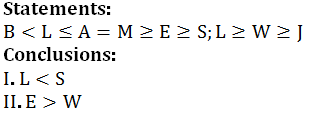
In the following questions, relationship between different elements are shown in the statements. The statements are followed by conclusions. Study the conclusions based on the given statement and select the appropriate answer:
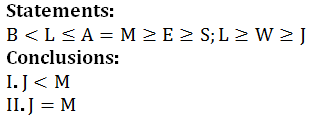
In the following questions, relationship between different elements are shown in the statements. The statements are followed by conclusions. Study the conclusions based on the given statement and select the appropriate answer:
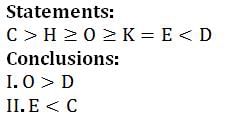
In a row of thirty five children, A is fifteenth from the right end and there are ten children between A and D. What is D’s position from the left end of the row?
In a row of thirty five children, A is fifteenth from the right end and there are ten children between A and D. What is D’s position from the left end of the row?
M and N are sisters. X and Y are brothers. M’s daughter is X’s sister. What is N’s relation to Y?
A is sister of B. B is married to D. D is father of C. H is son of G. B is mother-in-law of G. D has only one son and no daughter. A is married to E. F is daughter of A.How is H related to D?
Point A is 6 m west of point B. Point C is 5 m north of point S which is midway on the AB. Point C is 5 m west of point D. What is the distance B to D?


